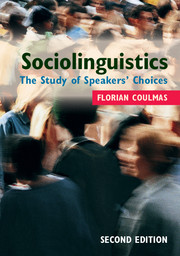Book contents
- Frontmatter
- Contents
- List of figures
- List of tables
- Preface to the second edition
- 1 Introduction: notions of language
- Part I Micro-choices
- Part II Macro-choices
- 7 Code-switching: linguistic choices across language boundaries
- 8 Diglossia and bilingualism: functional restrictions on language choice
- 9 Language spread, shift and maintenance: how groups choose their language
- 10 Language and identity: individual, social, national
- 11 Language planning: communication demands, public choice, utility
- 12 Select letters: a major divide
- 13 The language of choice
- 14 Research ethics
- Glossary of terms
- References
- Index
- References
7 - Code-switching: linguistic choices across language boundaries
Published online by Cambridge University Press: 05 August 2013
- Frontmatter
- Contents
- List of figures
- List of tables
- Preface to the second edition
- 1 Introduction: notions of language
- Part I Micro-choices
- Part II Macro-choices
- 7 Code-switching: linguistic choices across language boundaries
- 8 Diglossia and bilingualism: functional restrictions on language choice
- 9 Language spread, shift and maintenance: how groups choose their language
- 10 Language and identity: individual, social, national
- 11 Language planning: communication demands, public choice, utility
- 12 Select letters: a major divide
- 13 The language of choice
- 14 Research ethics
- Glossary of terms
- References
- Index
- References
Summary
In order to resume. Resume the – what is the word? What the wrong word?
Samuel Beckett, Ill Seen, Ill SaidThe speech which had started off one hundred percent in Ibo was now fifty-fifty. But his audience still seemed highly impressed. They liked good Ibo, but they also admired English.
Chinua Achebe, No Longer at EaseOutline of the chapter
Code-switching is a topic that comes into focus where two or more languages coexist in a community, forming the linguistic resources from which bilingual speakers can choose. In their conversations, these individuals do not necessarily choose one language or another, but often go back and forth. This chapter deals with the social and linguistic aspects of such speech behaviour. After introducing the concept of code-switching and distinguishing it from other language contact-related phenomena, it explains why the key term of this field of research is code-switching rather than, for example, language-switching and then goes on to discuss the questions, ‘Who switches?’, ‘How?’ and ‘Why?’ At the end of the chapter, brief mention is made of diachronic aspects of code-switching as a force of language change.
- Type
- Chapter
- Information
- SociolinguisticsThe Study of Speakers' Choices, pp. 121 - 140Publisher: Cambridge University PressPrint publication year: 2013

